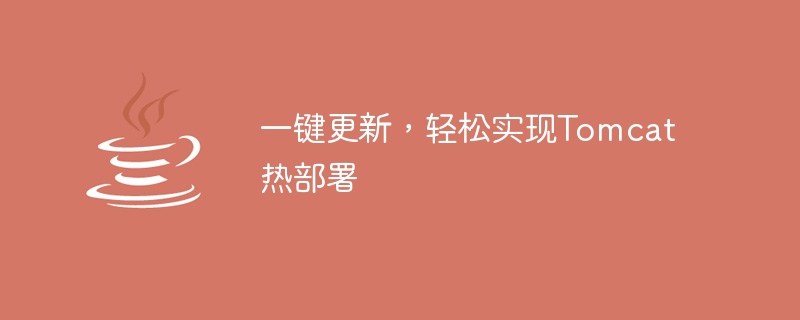

One-click update, easy to implement Tomcat hot deployment
Abstract:
As one of the most popular Java application servers, Tomcat provides flexible configuration and deployment options. However, during the development process, Tomcat needs to be manually restarted every time the code is modified, which is a very tedious task. This article will introduce an automation-based method to implement hot deployment of Tomcat using one-click update, which greatly improves development efficiency.
Introduction:
In the process of software development, frequent code modifications are normal. However, traditional application servers need to be manually restarted to make the code effective, which leads to low development efficiency. To solve this problem, many developers look for automated deployment solutions. In Java development, Tomcat is one of the most commonly used application servers. This article will introduce a method to implement Tomcat hot deployment using one-click update, and provide specific code examples.
1. Principle introduction:
Tomcat uses war files to deploy web applications. We can determine whether hot deployment is needed by monitoring the last update time of the war package. When the modification time of the war file changes, it means that the code has been updated. We can trigger Tomcat's reload action to achieve hot deployment.
2. Specific implementation:
First, we need an automatically reloaded class to trigger Tomcat's reloading action. The following is a simple implementation example:
public class HotReload { private static String webappsPath = "/path/to/webapps/"; // Tomcat的webapps目录 public static void reload(String appName) { try { MBeanServer mBeanServer = ManagementFactory.getPlatformMBeanServer(); ObjectName serviceName = new ObjectName("Catalina:type=Manager,context=" + appName + ",host=localhost"); mBeanServer.invoke(serviceName, "reload", null, null); } catch (Exception e) { e.printStackTrace(); } } // 监控war包的最后修改时间 public static long getLastModified(String appName) { File warFile = new File(webappsPath + appName + ".war"); return warFile.lastModified(); } public static void main(String[] args) { String appName = "myApp"; long lastModified = getLastModified(appName); while (true) { long currentModified = getLastModified(appName); if (currentModified > lastModified) { reload(appName); lastModified = currentModified; System.out.println("Reloaded " + appName); } try { Thread.sleep(1000); // 每秒检查一次 } catch (InterruptedException e) { e.printStackTrace(); } } } }
In the above code, the reload method uses Java's MBeanServer to call Tomcat's overloaded method. The getLastModified method is used to obtain the last modification time of the war package. In the main method, use a loop to monitor whether the war package has changed. If it has changed, call the reload method for reloading.
3. Application practice:
Create a new folder named "Catalina" in Tomcat's conf directory, and create a new xml file in the folder. The file name is the same as your application name. For example, for an app named "myApp", the file path is "conf/Catalina/myApp.xml". Add the following content to the xml file:
Add the following content to the setenv.sh (Linux) or setenv.bat (Windows) file in Tomcat's bin directory:
export JAVA_OPTS="$JAVA_OPTS -Djava.util.logging.config.file=$CATALINA_BASE/conf/logging.properties -Dreloadable.app=myApp"
The "myApp" here needs to be replaced with your application name.
4. Summary:
This article introduces a method to implement Tomcat hot deployment using one-click update. By regularly monitoring the last modification time of the war package and triggering Tomcat's reload action, hot replacement of the code is achieved. This automated method greatly improves development efficiency and reduces the tedious work of manually restarting Tomcat. I hope this article can be helpful to Java developers.
The above is the detailed content of Implement Tomcat hot deployment in a simple way: one-click update. For more information, please follow other related articles on the PHP Chinese website!
 How to configure Tomcat environment variables
How to configure Tomcat environment variables How to integrate idea with Tomcat
How to integrate idea with Tomcat How to view Tomcat source code
How to view Tomcat source code What are the common tomcat vulnerabilities?
What are the common tomcat vulnerabilities? How to solve garbled tomcat logs
How to solve garbled tomcat logs What are the differences between weblogic and tomcat
What are the differences between weblogic and tomcat What are the differences between tomcat and nginx
What are the differences between tomcat and nginx How to solve tomcat startup crash
How to solve tomcat startup crash



